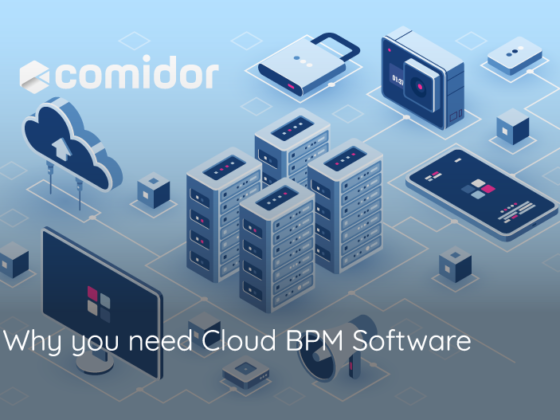The Cloud Platforms’ market is developing steadily, gaining more and more users every year. Leading enterprises increasingly admit the convenience of Cloud Computing. A Cloud Platform is a set of technologies for a wide range of tasks: from developing and running corporate and user applications, to storing and processing huge data assets, to training artificial intelligence software models. Continue reading this article to explore the benefits, features, and importance of Cloud Platforms for enterprises.
Turn to the Cloud side
A lot of organizations have already switched their work to the Cloud. According to RightScale research, over the last three years, the percentage of enterprises using Cloud services has grown from 89% to 92%. Nowadays, more than 80% of organisations with 1,000 or more employees are using several Cloud Platforms at the same time. This rate is expected to increase to 90% by 2024. Moreover, forecasts show that business expenses on Public Cloud Platforms will reach $277 billion by the end of 2021, up 73% from 2018. And the total Cloud services market should reach $350 billion in 2022.
 A good deal of companies is actively switching to Cloud computing, as it allows them to be flexible, competitive and agile. Also, the Cloud contributes to the continuous business improvement and helps employees work smarter and more productive. So, there are probably no companies that have not included the transition to the Cloud in their IT strategies. Isabelle Jordan from Ektra Traveling highlights that even the travel insurance business actively uses the Cloud platforms as a source of flexibility and process optimization that helps to make travel insurance as simple as possible.
A good deal of companies is actively switching to Cloud computing, as it allows them to be flexible, competitive and agile. Also, the Cloud contributes to the continuous business improvement and helps employees work smarter and more productive. So, there are probably no companies that have not included the transition to the Cloud in their IT strategies. Isabelle Jordan from Ektra Traveling highlights that even the travel insurance business actively uses the Cloud platforms as a source of flexibility and process optimization that helps to make travel insurance as simple as possible.
The benefits of Cloud Platforms
Above all, the most important benefit of Cloud Platforms is that all information is accessible from any device connected to the Internet. Experts also highlight the following benefits of using Cloud services:
- Reduced costs. According to experts, on average, Cloud services allow companies to cut down costs at 20-50%. Organizations save money by utilizing Cloud services rather than acquiring pricey, on-premise systems and hardware for their organization. Furthermore, with Cloud Platforms you pay only for the needed package of services.
- Convenience. Cloud Platforms enable easy access to company information via smartphones and other mobile devices. Employees with a heavy workload as well as people who work remotely can stay connected with customers and colleagues at all times, wherever they are.
- Efficiency and security. In today’s environment, even a short downtime may have a huge impact. Lost productivity, reduced profitability, and effects on brand could be some of the negative results. Cloud services often offer more robust data recovery mechanisms that organisations often forget about or insufficiently invest in them.
Types of Cloud Platforms and their Features
Currently, the variety of Cloud technologies can meet the requirements of companies of all sizes. There are three main types of Cloud environments, depending on the location of their services and the way of development.
 Private Cloud. It is available through a secure network for a single company. A private Cloud can be based on its own platforms or passed to a third-party provider. Its chief advantages: high visibility, customization, first-class security and control, ease of flexibility and scalability. Disadvantages: high price (this can be a major obstacle for SMBs) and complexity in maintenance (it may require single employees to support the private Cloud).
Private Cloud. It is available through a secure network for a single company. A private Cloud can be based on its own platforms or passed to a third-party provider. Its chief advantages: high visibility, customization, first-class security and control, ease of flexibility and scalability. Disadvantages: high price (this can be a major obstacle for SMBs) and complexity in maintenance (it may require single employees to support the private Cloud).- Public Cloud. The provider of such services offers them to lots of users at the same time. The provider also ensures technical support and takes care of the hardware and software. A public Cloud is much cheaper for customers than a private Cloud; it saves time and money and allows enterprises to focus on their major tasks. On the other hand, it is more vulnerable to cyberattacks and has limited customization capabilities.
- Hybrid Cloud. It has the form of private and public Cloud solutions. Typically, its resources are formed into a unique environment and distributed between Clouds to peak performance. A hybrid Cloud opens up almost unlimited opportunities for IT managers. Its private component guarantees security, while its public component helps manage helper business applications, like collaboration, people and project management apps.
Cloud Computing Trends
Bernard Marr, futurologist, strategy and technology consultant and author of “Tech Trends in Practice: The 25 Technologies that are Driving the 4th Industrial Revolution”, supposes what businesses should expect this change in the Cloud in 2021:
 Multi-Cloud approaches will break down barriers between service providers: At the present time, the big Public Cloud providers (Amazon, Microsoft, Google, etc.) have built a “fence” around their services. They bill themselves as a “general shop” where companies can meet all their storage and computing needs. But the more organizations turn to hybrid or multi-cloud solutions, the greater the demand for building bridges between different platforms becomes.
Multi-Cloud approaches will break down barriers between service providers: At the present time, the big Public Cloud providers (Amazon, Microsoft, Google, etc.) have built a “fence” around their services. They bill themselves as a “general shop” where companies can meet all their storage and computing needs. But the more organizations turn to hybrid or multi-cloud solutions, the greater the demand for building bridges between different platforms becomes.- Artificial Intelligence will increase the efficiency and speed of Cloud computing: Artificial Intelligence is the technology that enhances Cloud Computing and makes it a useful tool for enterprise adaptation to changing conditions. Finally, Cloud platforms allow users with almost any budget and any skill level to access machine learning features like image recognition, speech processing, etc. And in the future, the possibilities of using such services will only increase, becoming accessible for companies of any size and from any field. As a result, productivity will increase dramatically.
- Hybrid Cloud will grow in popularity: A multi-cloud approach ensures the greatest performance from several Cloud providers, whether private or public. A hybrid Cloud strategy, on the other hand, focuses on making use of both environments. Enterprises may benefit from the public Cloud’s scalability and performance without sacrificing the private Cloud’s cost-effectiveness and reliability. Furthermore, the hybrid Cloud market is expected to reach a value of USD 100 billion by 2023, with an annual growth rate of 17%.
Conclusion
Cloud technology is a trend that will be with us for a long time and will only gather pace. After all, a Cloud Platform is not just a useful tool for saving data and performing computations. It helps companies adapt to the changes whose scale and dynamics are on the rise.
Author Bio
Isabelle Jordan is a business and marketing journalist at Ekta Traveling insurance company. She writes for different news portals and thematic blogs that helps her stay at the heart of the travel and insurance news. Isabelle knows everything and more about travel insurance.
Achieve meaningful intelligent automation
with Comidor Cloud Platform





